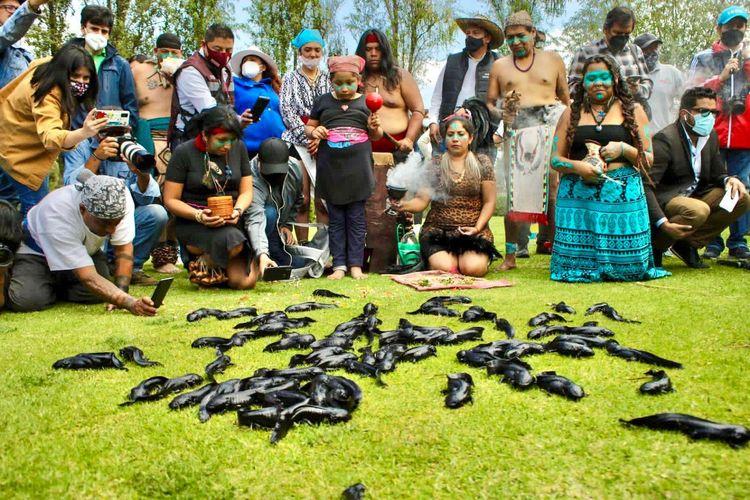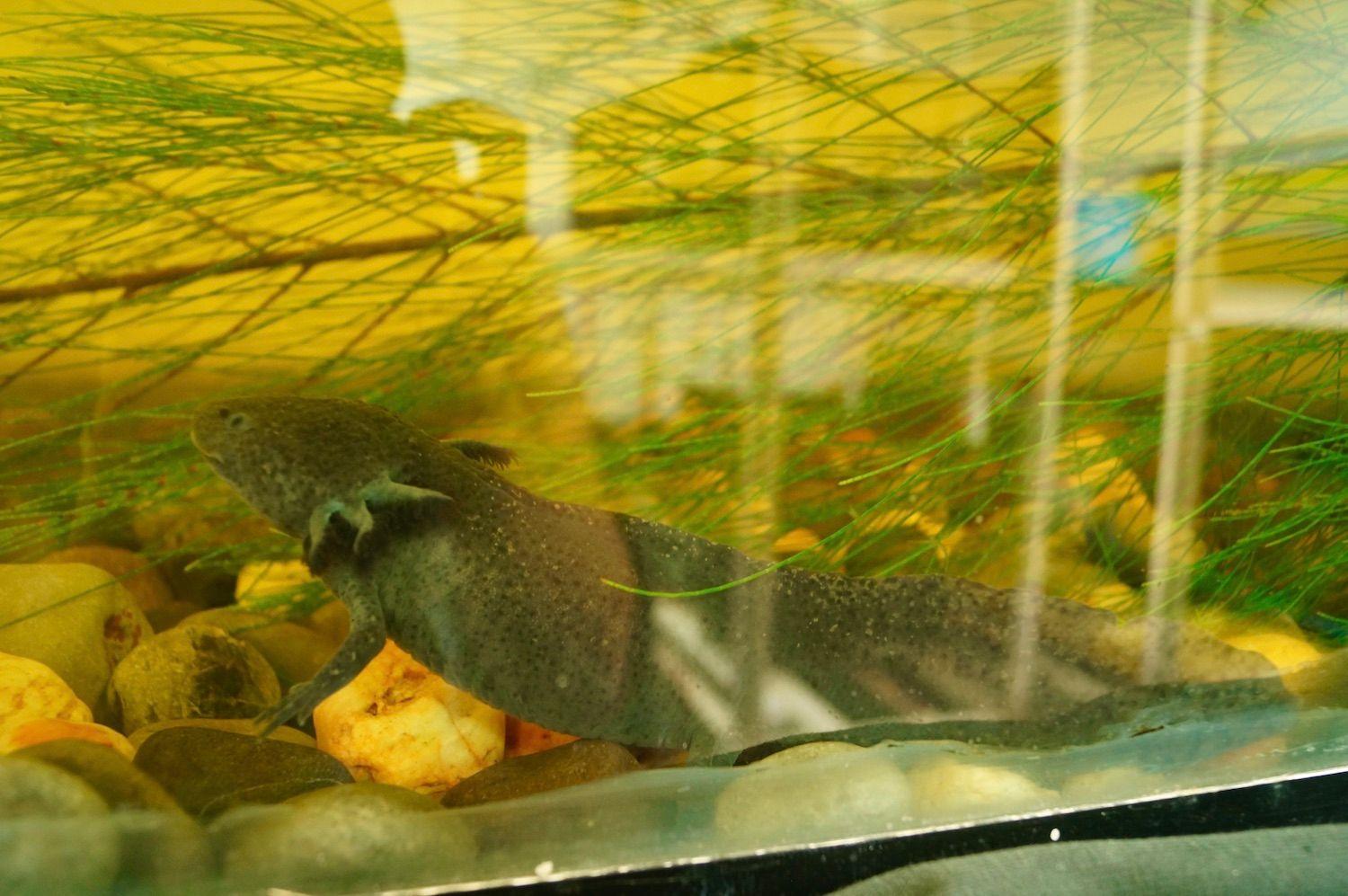Between the tall grass and the smell of the canals of Xochimilco, south of Mexico City, there is a community of 300 axolotls under conservation. All have been born and raised for the last 15 years in purified water ponds, distributed over the 1.2 hectares that make up the Cuemanco Biological and Aquaculture Research Center (CIBAC).
Problems with wastewater treatment and pollution from tourism in the area are threats faced by these amphibians.
But CIBAC is even more concerned about irregularities in the monitoring of the species, including the inspection of environmental authorities, the liability of producers and the purchase and sale of axolotl.
“There is no strict control over the management of the species. Everyone distributes axolotls everywhere, but they don't know where they come from, what their origin is, if they have had diseases, if they carry parasites, who they have crossed paths with...”, said José Antonio Ocampo Cervantes, CIBAC project manager.
The researcher argues that there is an impact on genetic variability due to the lack of follow-up in the management of the species. This leads to the birth of axolotls with diseases and malformations that, when released, introduce 'unhealthy genetics' into wild populations.
“This is a problem for a species (such as the axolotl) whose population is very small... There are those who produce them, but very few have their records and even fewer have good control over the reproduction of these animals...”, added Ocampo.
In accordance with the General Wildlife Law, to have specimens at risk, it is necessary to prepare a management plan that will be evaluated by the Secretariat of Environment and Natural Resources (Semarnat).
These reports include biological information about the species; descriptions of the confinement area; clinical, health, safety and hygiene care; activity schedules, as well as surveillance and contingency mechanisms. The list is detailed in Article 78 Bis of that Act.
“You do your paperwork with Semarnat and those responsible check that you comply with your facilities, with the permits, with the legal origin of the copies. But it's no longer Semarnat's responsibility to see that people comply with procedures. Maybe if you then have a visit from an inspector, he finds some interference and he can sanction you...”, described the researcher.
Article 104 specifies that Semarnat will also carry out acts of inspection and surveillance, as well as a register of violators of the law.
“But it is also the responsibility of those who manage the organisms to see what the origin of animals is, with whom they can cross them and with whom they cannot, to continue to guarantee the genetic variability of the species, which is one of the strongest problems,” he added.
In the case of CIBAC, it has been achieved that of the 32 copies that arrived in 2007, the community currently reaches 300. They all have a genealogical record that, through the use of microchips, allows the identification of each one.
Between sewage
On March 4, the Coordination of Villages of Xochimilco filed a complaint against Mayor José Carlos Acosta Ruíz with the Federal Attorney for Environmental Protection (Profepa).
The reason for the complaint is the 'Ajolotón', an event held in February where the mayors and mayors of Iztacalco, Gustavo A. Madero, Iztapalapa, Milpa Alta, Tláhuac and Xochimilco released 200 axolotls into the waters of the canals.
The authorities argued that it was carried out under the advice of researchers from the National Autonomous University of Mexico (UNAM), but it was the images that were shared on social networks that sparked criticism from citizens about the management of amphibians, which remained out of the water and exposed to the sun to be photographed.
Environmental activists and specialists argued that there was a risk of them causing bacterial and fungal infections. It was even said that they would not survive the waters of the canal whose contamination by wastewater has been documented in recent decades.
“The lake (in Xochimilco) has environmental damage because it receives dirty water from the Cerro de la Estrella treatment plant, in Iztapalapa,” explained Ana Luisa González Arévalo, a researcher at the UNAM who specializes in the subject.
In 2019, the researcher gave a paper where she stated that on the margins of the mayor's channels there were an average of 1,374 discharges of black and gray water. This had also been documented two years ago by three researchers from the university's Institute of Engineering.
“In addition, the houses that are around the lake produce waste that falls into the canal. There we found plastics, batteries, insecticides, fertilizers. The lake is the recipient of all waste,” added González Arévalo.
For Dr. José Antonio Ocampo of CIBAC, tourism and the use of boats with outboard motors must also be considered as part of the risk affecting the entire lake ecosystem.
“When we were in a pandemic, when there was no such circulation (of tourists and boats), the water returned to a certain level of transparency, more animals were seen and there was a greater presence of birds,” said the researcher.
In addition, Xochimilco has an annual reception of an average of 1.2 million domestic and foreign tourists who, sometimes, release axolotls without knowledge of their biological condition.
“The greatest risk is people who are not aware of the damage they can cause by coming to release specimens that we don't know what their origin is or that are even of another species... That's a problem because we're bringing axolotls from other places that we don't know what impact they can have here,” Ocampo explained.

'Axoloton' event. Photo: Gustavo A. Madero Mayor's Office
Debts with the axolotl
In Mexico, the Xochimilco Ecological Rescue Plan, developed by the Municipal Ecological Park, is a reference for other sanctuaries and conservation centers in the region that focus on ambystoma mexicanum, the best-known species of axolotl.
“But the idea is to work with other species such as ambystoma altamirani, which is the mountain axolotl and that little is known about it, but which may be at greater risk because there are no breeding colonies, the species is not managed,” Ocampo explained.
During the interview with Journalism Causa Natura, both specialists agreed that there is no single person responsible who can solve the problems of conservation of the axolotl and the lake area.
“It's a problem for everyone, for the authorities, for civil groups, for landlords, for users and tourists. Environmental education is needed, mainly because if you don't educate users about what they should keep, they don't see beyond what it means to have this space for all of Mexico City,” added the researcher.
But Dr. Ocampo clarifies that the evidence should not generate catastrophic scenarios regarding the environmental state, despite research that has given time limits for the existence of the species.
He even reported that the CIBAC is planning to release axolotls, but the procedure may take at least a year. Following the management plan, it will be necessary to carry out previous studies to assess the situation of the ecosystem and the specimens it could support.



Comentarios (0)